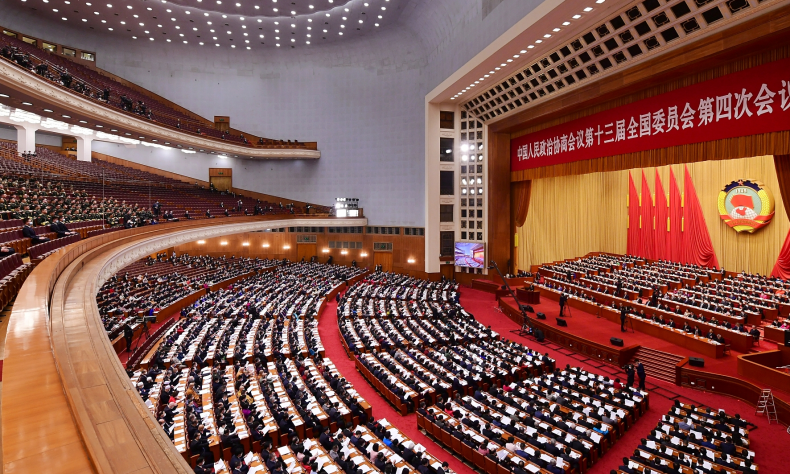Anchoring Expectations as Two Sessions’ Main Objective

Interestingly, the growth target for 2021 is pretty humble: over 6 percent for 2021, while most forecasts hover between 7 and 10 percent.
After a very unpredictable and difficult 2020, this year’s Two Sessions in China – the National People’s Congress (NPC) and the National Committee of the Chinese People’s Political Consultative Conference (CPPCC) – which have started with the traditional government work report has mainly aimed at anchoring expectations for the Chinese economy this year and beyond.
In fact, after having omitted a growth target last year, Premier Li has, somewhat unexpectedly, set a GDP growth target for 2021, other than targets for inflation, fiscal deficit as has always been the case, even in 2021.
Interestingly, the growth target for 2021 is pretty humble: over 6 percent for 2021, while most forecasts hover between 7 and 10 percent. The International Monetary Fund (IMF), for example, expects China to grow 8.1 percent in 2021. One could, thus, argue that the 6 percent minimum target does not necessarily help lead market expectations as it did before 2019.
I would argue that it does, in as far as you look at the right timeframe. In fact, Chinese policy makers are fully aware of the very positive base effect which will push up growth this year and the negative base effect which will push down growth next year. Stability is absolute key for Chinese policy makers and having chosen a higher target for 2021 would have implied that a much lower growth target would need to be announced in 2022. This is really not the best way to guide expectations.
One of the key consequences of announcing a growth target below expectations is that monetary and fiscal policy will not be as supportive in 2021 as in 2020, not even as supportive as expected prior to the Government report. In fact, the target for the general public deficit over GDP has been reduced slightly to 3.2 percent and the same is true for inflation, whose target is now 3 percent. This also means that 2022 will still have some stimulus so as to smooth the growth rate curve. All in all, the Chinese government is expected to reduce its fiscal support but not to eliminate it.
All in all, the GDP target, together with the announced fiscal measures shows that the government is already thinking beyond 2021. This comes in two ways, first smoothing growth developments in 2021 and 2022 but also beyond with structural measures.
For the latter, three important structural aspects have received great attention but another key one is absent. The first three are tackling the rapidly aging population, innovation and opening up new markets. The missing one is the reform of state-owned enterprises and the larger role of the market which had been visible in the previous Five-Year Plan (2016-2020). Regarding the first structural target, namely reducing the impact of aging in the economy, the government has made clear that it will start to deal with the population aging issue. The rise in the statutory retirement age will be implemented in a phased manner. Furthermore, policies to increase the fertility rate are to be expected.
The second, innovation, comes with research and development growing faster than GDP and additional subsidies especially for companies to collaborate in research.
The third objective, opening new markets to trade and investment, is covered by China’s recent announcements of successful trade and investment deals in Asia and Europe (RCEP and CAI), but also accelerating free trade negotiations with Japan and South Korea and even joining the Comprehensive and Progressive Agreement for Trans-Pacific Partnership (CPTPP).
Besides, an important aspect for China’s structural challenges are SOEs, given their generally lower return on assets and their still dominant position in quite a few sectors. Neither the 14th Five-Year Plan (2021-2025) targets nor the Government report seem to focus on this topic, which leads me to conclude that the role of the state in the Chinese economy is expected to remain pervasive.
All in all, the two sessions seem to be moving beyond 2021 with targets which guide expectations for 2021 into 2022 and beyond. The relatively low growth target for 2021 actually helps maintain a rather stable path for growth in 2021 and 2022. Furthermore, it frees some resources which would have otherwise gone to continue to stimulate the economy towards more structural issues, which are needed to avoid a too rapid reduction in potential. The most obvious is aging, which will require some sacrifice in terms of increasing the retirement age. Secondly, more innovation is needed to acquire self-sufficiency but also boost productivity.
Finally, new markets are key as China’s population shrinks and China continues to accumulate production capacity. Trade and investment deals are indeed very important and more will come. The only important point that seems to be missing, though, is a change in the model of production.
The author is Chief Economist for Asia Pacific at NATIXIS and Senior Research Fellow at Bruegel.
The article reflects the author’s opinions, and not the views of China Focus.
 Facebook
Facebook
 Twitter
Twitter
 Linkedin
Linkedin
 Google +
Google +










